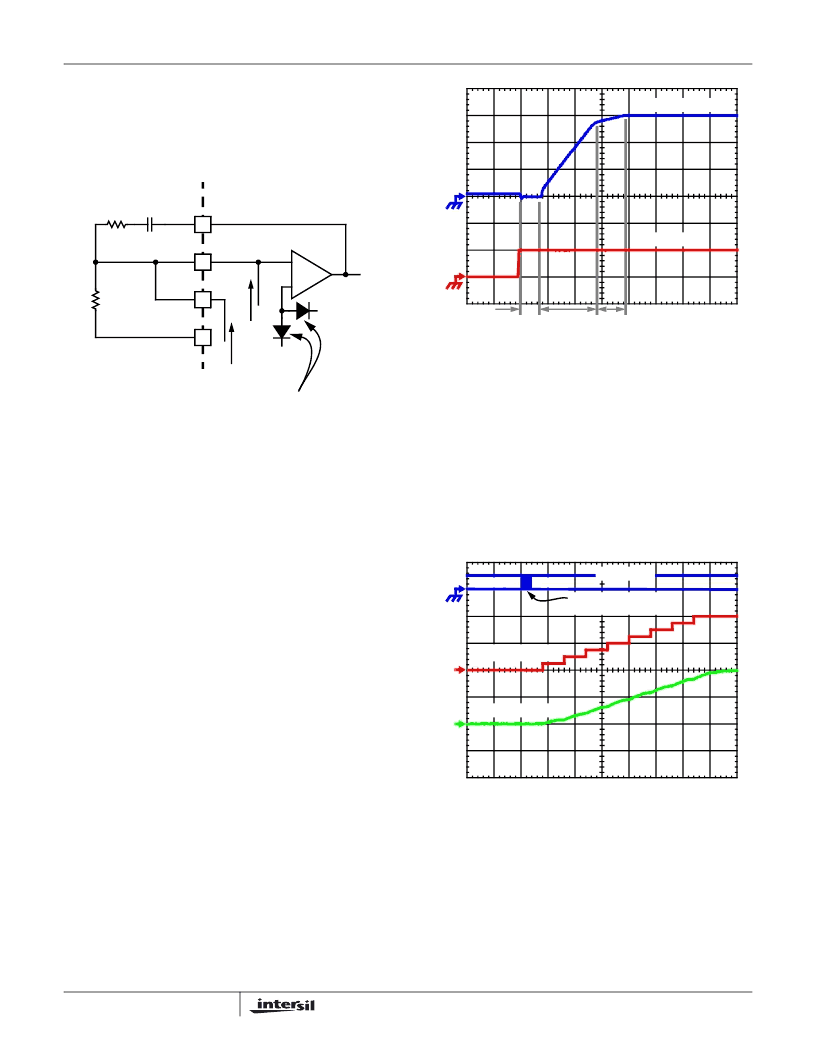- 您現(xiàn)在的位置:買賣IC網(wǎng) > PDF目錄383156 > ISL6557CB (INTERSIL CORP) PWM Controller with Wide Input Voltage Range 8-PDIP -20 to 85 PDF資料下載
參數(shù)資料
| 型號(hào): | ISL6557CB |
| 廠商: | INTERSIL CORP |
| 元件分類: | 穩(wěn)壓器 |
| 英文描述: | PWM Controller with Wide Input Voltage Range 8-PDIP -20 to 85 |
| 中文描述: | SWITCHING CONTROLLER, 1500 kHz SWITCHING FREQ-MAX, PDSO24 |
| 封裝: | PLASTIC, MS-013AD, SOIC-24 |
| 文件頁(yè)數(shù): | 11/17頁(yè) |
| 文件大小: | 532K |
| 代理商: | ISL6557CB |
第1頁(yè)第2頁(yè)第3頁(yè)第4頁(yè)第5頁(yè)第6頁(yè)第7頁(yè)第8頁(yè)第9頁(yè)第10頁(yè)當(dāng)前第11頁(yè)第12頁(yè)第13頁(yè)第14頁(yè)第15頁(yè)第16頁(yè)第17頁(yè)

11
During the soft-start interval, the soft-start voltage, V
RAM
P
,
increases linearly from zero to 140% of the programmed
DAC voltage. At the same time a current source, I
RAMP
, is
decreasing from 160
μ
A down to zero. These signals are
connected as shown in Figure 9 (I
OUT
may or may not be
connected to FB depending on the particular application).
The ideal diodes in Figure 9 assure that the controller tries to
regulate its output to the lower of either the reference voltage or
VRAMP. Since IRAMP creates an initial offset across RFB of
RFB times 160mA, the first PWM pulses will not be seen until
VRAMP is greater than the R
F
B
I
RAMP
offset. This produces a
delay after the ISL6557 enables before the output voltage starts
moving. For example, if VID = 1.5V, RFB = 1k
and
TSS = 8.3ms, the delay can be expressed using Equation 6.
From this point, the soft-start ramps linearly until V
RAMP
reaches VID. For the system described above, this first
linear ramp will continue for approximately
The final portion of the soft-start sequence is the time
remaining after V
RAMP
reaches VID and before I
RAMP
gets to
zero. This is also characterized by a slight linear ramp in the
output voltage which, for the current example, exists for a time
This behavior is seen in the example in Figure 10 of a converter
switching at 500kHz. For this converter, R
FB
is set to 2.67k
leading to T
SS
= 4.0ms, t
DELAY
= 700ns, t
RAMP1
= 2.23ms,
and t
RAMP2
= 1.17ms.
NOTE: Switching frequency 500kHz and R
FB
= 2.67k
DYNAMIC VID
The ISL6557 is capable of executing on-the-fly output-
voltage changes. At the beginning of the phase-1 switching
cycle (defined in the section entitled
PWM Operation
), the
ISL6557 checks for a change in the VID code. The VID code
is the bit pattern present at pins VID4-VID0 as outlined in
Voltage Regulation
. If the new code remains stable for
another full cycle, the ISL6557 begins incrementing the
reference by making 25mV change every two switching
cycles until the it reaches the new VID code.
Since the ISL6557 recognizes VID-code changes only at the
beginnings of switching cycles, up to one full cycle may pass
before a VID change registers. This is followed by a one-
cycle wait before the output voltage begins to change. Thus,
the total time required for a VID change, t
DV
, is dependent
on the switching frequency (f
S
), the size of the change
(
V
ID
), and the time before the next switching cycle begins.
FIGURE 9. RAMP CURRENT AND VOLTAGE FOR
REGULATING SOFT-START SLOPE
AND DURATION
-
+
I
AVG
REFERENCE
VOLTAGE
EXTERNAL CIRCUIT
ISL6557 INTERNAL CIRCUIT
COMP
C
C
R
C
R
FB
FB
IOUT
VDIFF
ERROR AMPLIFIER
V
COMP
V
RAMP
I
RAMP
IDEAL DIODES
t
DELAY
T
FB
160
1
10
6
–
×
----------------------------------------
+
--------------------------------------------------
580
μ
s
=
=
(EQ. 6)
t
RAMP1
T
----------
t
DELAY
–
=
5.27ms
=
(EQ. 7)
t
RAMP2
T
SS
t
RAMP1
–
t
DELAY
–
=
2.34ms
=
(EQ. 8)
FIGURE 10. SOFT-START WAVEFORMS FOR ISL6557 BASED
MULTI-PHASE BUCK CONVERTER
1ms/DIV
EN, 5V/DIV
VOUT, 500mV/DIV
t
DELAY
t
RAMP1
t
RAMP2
FIGURE 11. DYNAMIC-VID WAVEFORMS FOR 500kHZ
ISL6557 BASED MULTI-PHASE BUCK
CONVERTER
5
μ
s/DIV
V
REF
, 100mV/DIV
V
OUT
, 100mV/DIV
1.5V
V
ID
, 5V/DIV
01110
00110
1.5V
VID CHANGE OCCURS
ANYWHERE HERE
ISL6557
相關(guān)PDF資料 |
PDF描述 |
|---|---|
| ISL6558CRZA-T | Multi-Purpose Precision Multi-Phase PWM Controller With Optional Active Voltage Positioning |
| ISL6558IB | Multi-Purpose Precision Multi-Phase PWM Controller With Optional Active Voltage Positioning |
| ISL6558IB-T | Multi-Purpose Precision Multi-Phase PWM Controller With Optional Active Voltage Positioning |
| ISL6558IBZ | Multi-Purpose Precision Multi-Phase PWM Controller With Optional Active Voltage Positioning |
| ISL6558IBZ-T | Multi-Purpose Precision Multi-Phase PWM Controller With Optional Active Voltage Positioning |
相關(guān)代理商/技術(shù)參數(shù) |
參數(shù)描述 |
|---|---|
| ISL6557CB-T | 制造商:Intersil Corporation 功能描述: |
| ISL6557CB-T WAF | 制造商:Intersil Corporation 功能描述: |
| ISL6558CB | 功能描述:DC/DC 開(kāi)關(guān)控制器 Precision MultiPhase RoHS:否 制造商:Texas Instruments 輸入電壓:6 V to 100 V 開(kāi)關(guān)頻率: 輸出電壓:1.215 V to 80 V 輸出電流:3.5 A 輸出端數(shù)量:1 最大工作溫度:+ 125 C 安裝風(fēng)格: 封裝 / 箱體:CPAK |
| ISL6558CB-T | 功能描述:IC REG CTRLR BUCK PWM 16-SOIC RoHS:否 類別:集成電路 (IC) >> PMIC - 穩(wěn)壓器 - DC DC 切換控制器 系列:- 標(biāo)準(zhǔn)包裝:4,000 系列:- PWM 型:電壓模式 輸出數(shù):1 頻率 - 最大:1.5MHz 占空比:66.7% 電源電壓:4.75 V ~ 5.25 V 降壓:是 升壓:無(wú) 回掃:無(wú) 反相:無(wú) 倍增器:無(wú) 除法器:無(wú) Cuk:無(wú) 隔離:無(wú) 工作溫度:-40°C ~ 85°C 封裝/外殼:40-VFQFN 裸露焊盤 包裝:帶卷 (TR) |
| ISL6558CBZ | 制造商:Intersil Corporation 功能描述:- Rail/Tube |
發(fā)布緊急采購(gòu),3分鐘左右您將得到回復(fù)。